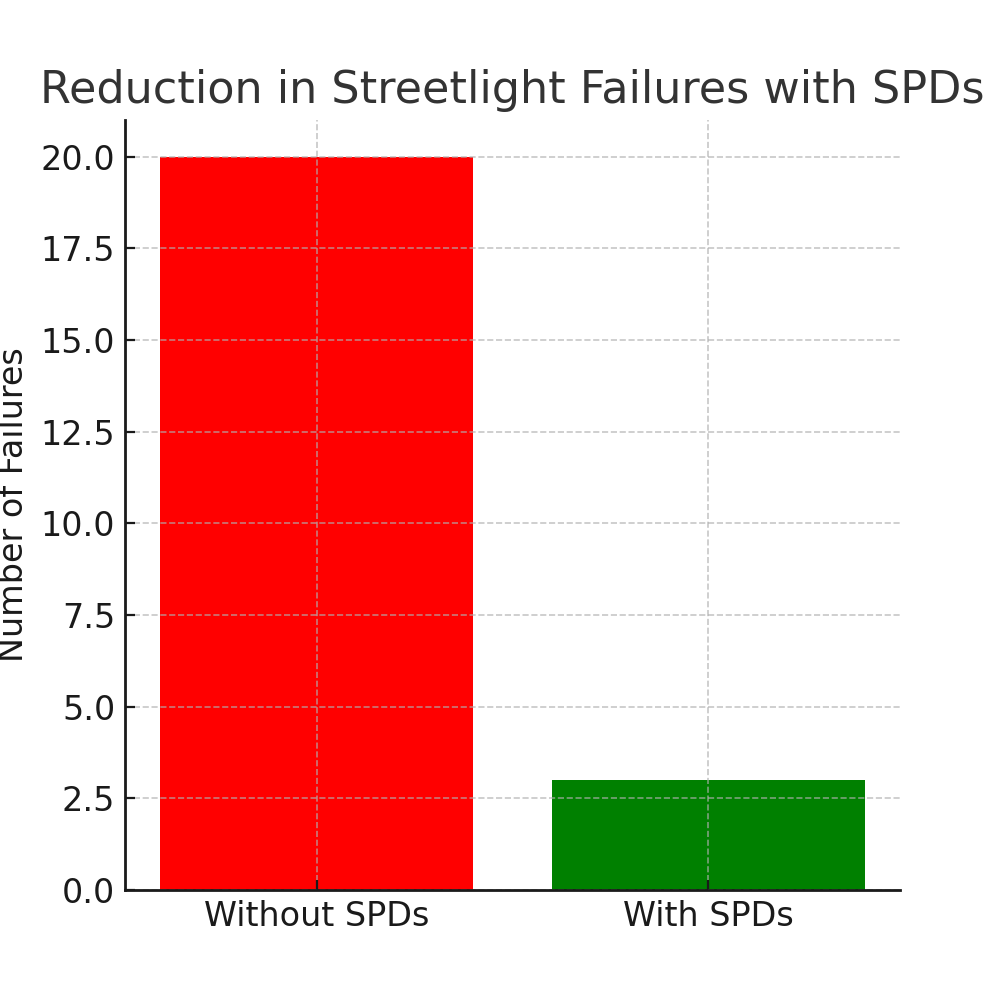Introduction
Street lighting is an essential element in urban infrastructure, providing safety, security, and visibility for both pedestrians and drivers. The continuous operation of street lighting systems, particularly in outdoor environments, requires reliable and durable components. Among these, Surge Protection Devices (SPDs) play a crucial role in safeguarding street lights from power surges, ensuring their longevity and functionality. This article explores the importance of surge protection in street lighting systems and how it can enhance their reliability, especially in the face of unpredictable electrical events like lightning strikes and voltage spikes.
1. The Necessity of Surge Protection
1.1 The Impact of Lightning Strikes and Voltage Transients
Surge protection is vital because outdoor lighting systems are particularly vulnerable to electrical surges caused by lightning strikes or other voltage transients. A lightning strike can induce massive spikes in voltage, which, when transmitted through power lines, can cause irreparable damage to street lighting components. The damage may not be immediate but can lead to equipment failures over time, including burned-out drivers, damaged LED chips, or even total system failure (Cerz8 Industry News).

1.2 The Vulnerability of LED Fixtures
LED lighting has become the standard for modern street lighting due to its energy efficiency and long lifespan. However, LED fixtures are more sensitive to voltage fluctuations compared to traditional lighting technologies like sodium lamps. Even a short voltage spike can damage the delicate circuits of an LED system, reducing its performance and lifespan. Surge protection devices are designed to prevent these spikes from reaching the LED units, thus protecting them from potential harm .

2. How Surge Protection Devices (SPDs) Work
2.1 Basic Functionality of SPDs
Surge Protection Devices are specialized components that detect voltage spikes and divert excess energy to the ground, thus preventing it from reaching the connected equipment. These devices are installed in street lighting systems to monitor and regulate the flow of electrical current, ensuring that any transient overvoltage does not harm the light fixtures. SPDs act as a barrier between the source of the surge (such as a lightning strike) and the sensitive lighting equipment .
2.2 Types of SPDs
There are different types of SPDs, each suited for particular applications depending on the level of protection required. The most common types used in street lighting include:
- Type 1 SPD: Installed at the point of entry to the electrical installation, protecting the entire system from high-energy surges, typically caused by lightning strikes.
- Type 2 SPD: Installed at the distribution board, offering protection for lighting circuits from smaller, but still potentially damaging surges.
- Type 3 SPD: Typically installed at the device level, offering the final layer of defense against surges that might reach the lighting equipment.
Each type serves a unique role in ensuring comprehensive surge protection in a street lighting system, and their use is often determined by local regulations and specific needs (TE Surge Protection for LED Lights).

3. Implementing Surge Protection in Street Lighting
3.1 Installation Location and Design Considerations
The placement of SPDs in street lighting systems is critical for their effectiveness. Ideally, SPDs should be installed at key points in the electrical distribution network, including at the junction box, at the power supply entry point, and close to the lighting fixtures themselves. Proper design ensures that surges are effectively diverted away from sensitive equipment. The SPD must be selected based on factors like the geographic location (e.g., areas prone to frequent lightning) and the voltage rating of the lighting system (Dehn Surge Protection Concept).
3.2 Case Study: LED Street Lighting Retrofit in a German City
A notable example of effective surge protection implementation can be found in a LED street lighting retrofit project in a German city. By incorporating SPDs into the city’s street lights, the local government significantly reduced the risk of damage caused by lightning strikes and power surges. The project also highlighted the benefits of proactive surge protection in extending the lifespan of the newly installed LED fixtures, ultimately leading to cost savings through reduced maintenance and replacement (TE Surge Protection for LED Lights).

4. Surge Protection Standards and Regulations
4.1 Overview of International Standards
Several international standards govern the use of surge protection in street lighting systems. These include IEC 61643, which provides guidelines for SPD installation and testing, and IEC 61000, which defines electromagnetic compatibility (EMC) requirements. Compliance with these standards ensures that surge protection devices offer the necessary reliability and protection for street lighting systems, which must endure both environmental and electrical stresses (Philips Surge Protection White Paper).

4.2 The Importance of Compliance
Adhering to international surge protection standards is crucial for ensuring the safety and functionality of street lighting installations. Non-compliance could lead to unforeseen equipment failures, potentially causing disruptions in public lighting and increasing maintenance costs. Therefore, manufacturers and municipalities must prioritize compliance to guarantee the long-term performance of street lighting infrastructure .
5. Future Trends in Surge Protection
5.1 Technological Advancements
The future of surge protection devices is heavily influenced by ongoing technological advancements. New materials, smarter surge detection systems, and improved energy diversion methods are expected to enhance the performance and efficiency of SPDs. These innovations will not only provide better protection against power surges but also improve the integration of surge protection into smart city networks .
5.2 Sustainability and Energy Efficiency
As cities strive to meet sustainability goals, surge protection systems will play a role in energy-efficient urban development. By preventing equipment failures and reducing the frequency of system replacements, SPDs contribute to the overall sustainability of street lighting. Furthermore, the continued adoption of LED technology and integration with smart city grids will necessitate even more robust surge protection solutions that align with energy-saving objectives .
Conclusion
Surge protection is a critical element in ensuring the reliable performance of street lighting systems. By mitigating the risks associated with power surges, lightning strikes, and voltage fluctuations, surge protection devices help to safeguard the longevity and efficiency of modern street lights, particularly LED fixtures. The implementation of SPDs not only ensures compliance with international standards but also supports sustainable urban development. As technology continues to evolve, surge protection solutions will become more advanced, providing even greater resilience for the street lighting of tomorrow.
For future research, the development of smarter, more integrated surge protection technologies and their role in intelligent city infrastructure will continue to shape the future of urban lighting systems.

